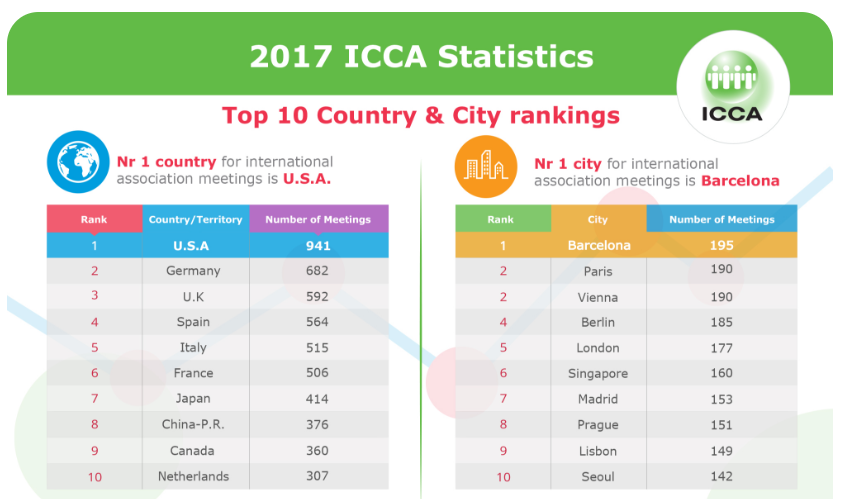Summary:
- The International Congress and Convention Association (ICCA) captured a record number of 12,558 rotating international association meetings taking place in 2017, up +2.8% on the previous year;
- As it has done for the past two decades, USA remains in the number one position ahead of Germany and the United Kingdom;
- Barcelona claims the top city spot for city meetings in 2017 for the first time since 2004, leapfrogging Paris and Vienna;
- After a period of exponential growth ICCA is seeing the industry "transcending into a more mature, but still solid, growth pattern".
In another successful year for the international association meetings industry, ICCA captured a record number of 12,558 rotating international association meetings taking place in 2017, with 346 additional meetings taking place compared to 2016. This is the highest annual figure that ICCA has ever recorded in its yearly analysis of the immediate past year's meetings data.
"In a world of disruption and unpredictability, the continuing growth in international association meetings is a welcome anomaly, but is not that surprising," explains Martin Sirk, CEO ICCA. "We are still in a period of revolutionary change in terms of scientific and technological advancements. To make sense of the tsunami of new data and information, association communities need to meet."
According to Mr Sirk this will go beyond traditional, well-established meetings, but will lead to the introduction of new gatherings specifically invented to serve new academic fields or to reach out to new audiences. "These are the pressures that we believe will continue to boost the sector for many years to come," he adds.
After a period of exponential growth ICCA is seeing the industry enter maturity. In its advocacy report 'A Modern History of International Association Meetings: 1963-2013', it identified a 50-year trend of exponential growth in the number of international association meetings. Effectively, the number of meetings doubled around every ten years. However, now this exponential growth seems to be slowly transcending into a more mature, but still solid, growth pattern, according to the company, which represents the world's leading suppliers in handling, transporting and accommodating international meetings and events,
The annual ICCA country and city rankings report provides a respected global comparison of the destinations attracting international meetings. However, it does only cover a narrow segment of the meetings industry, only including international association meetings that rotate between at least three countries, have a proven attendance of at least 50 participants, and are held on a regular basis, so is not a definitive guide to the overall meetings industry.
Its latest findings for 2017 show no change in top ten country rankings, apart from a minor shift in positioning. As it has done for the past two decades, USA remains in the number one position with 941 meetings, 7 more than reported at this time in 2016. The countries in the top 3 have not changed, with Germany and United Kingdom remaining in second and third place. France exits the top 5 and drops to sixth place with the rise of Spain and Italy.
While the top of the country ranking has been static, the city rankings show notable movement and has seen Barcelona claim the top city spot for the first time since 2004. The cities in this year's ICCA top five actually remain the same as they have done since 2015, but Barcelona has surpassed regular first and second place holders Paris and Vienna to claim the top spot, with Berlin and London placed in fourth and fifth. It remains a European-centric table with Madrid in seventh, Prague in eighth and Lisbon in ninth: the only non-European cities in the top ten are Singapore in sixth and Seoul in tenth.
But, outside of the top ten there has been notable city movement. Amsterdam has dropped out of the top ten and down to sixteenth.Notable risers were Buenos Aires, jumping from seventeenth to eleventh; Budapest, jumping from sixteenth to twelfth; and Hong Kong rising from nineteenth to thirteenth. Newcomers to the top 20 in 2017 comprised Tokyo and Montreal.
